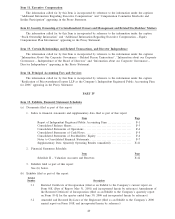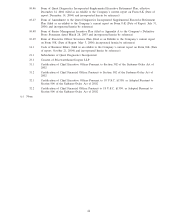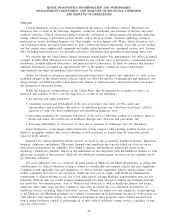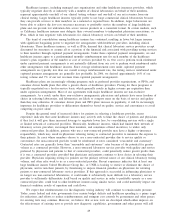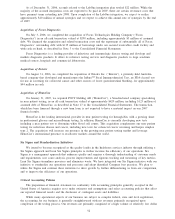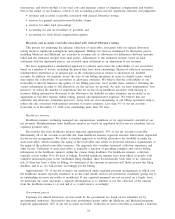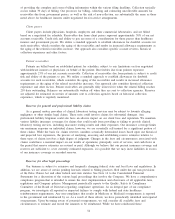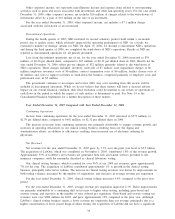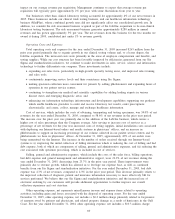Quest Diagnostics 2006 Annual Report Download - page 71
Download and view the complete annual report
Please find page 71 of the 2006 Quest Diagnostics annual report below. You can navigate through the pages in the report by either clicking on the pages listed below, or by using the keyword search tool below to find specific information within the annual report.these tests as covered services, because of the importance of laboratory testing in assessing and managing the
health of patients. We continue to emphasize the importance and the high value of laboratory testing with
healthcare insurers, and government payers at the federal and state level.
The diagnostic testing industry is labor intensive. Employee compensation and benefits constitute
approximately one-half of our total costs and expenses. Cost of services consists principally of costs for
obtaining, transporting and testing specimens. Selling, general and administrative expenses consist principally of
the costs associated with our sales and marketing efforts, billing operations (including bad debt expense), and
general management and administrative support. In addition, performing diagnostic testing involves significant
fixed costs for facilities and other infrastructure required to obtain, transport and test specimens. Therefore,
relatively small changes in volume can have a significant impact on profitability in the short-term.
Information systems are used extensively in virtually all aspects of our business, including laboratory testing,
billing, customer service, logistics, and management of medical data. Our success depends, in part, on the
continued and uninterrupted performance of our information technology systems. Through proper maintenance,
staffing and investment in our information technology systems, we expect to reduce the risks associated with our
heavy reliance on these systems.
The diagnostic testing industry is subject to seasonal fluctuations in operating results and cash flows.
Typically, testing volume declines during the summer months, year-end holiday periods and other major holidays,
reducing net revenues and operating cash flows below annual averages. Testing volume is also subject to declines
due to inclement weather or other events, which can deter patients from having testing performed and which can
vary in severity from year to year.
Recent Changes in Payer-Relationships
On October 3, 2006, we announced that we would not be a national contracted provider of laboratory
services to UNH, beginning January 1, 2007. After negotiating with UNH and offering to substantially reduce
their total costs for laboratory services, UNH abruptly demanded that we execute an agreement that would have
significantly reduced fees from what we had offered, and would have given UNH the right to unilaterally dictate
certain key terms over a period of up to eight years. We determined that in the long term, signing such an
unreasonable agreement would not be in the best interest of our Company and our shareholders.
UNH accounted for approximately 7% of our net revenues in 2006, with some of our regional laboratories
having concentrations as high as 15% to 20%. As one of many contracted providers, we estimate that we served
approximately half of UNH’s members or approximately three times as many as our single largest competitor.
We believe that this was because physicians and patients preferred using us due to quality and convenience.
While we expect to continue to service UNH’s members in certain limited markets as a contracted provider and
in other markets as a non-contracted provider, UNH has threatened physicians with penalties if they continue to
send laboratory testing to non-contracted providers as of March 1, 2007. We believe UNH’s actions are
unprecedented and inappropriate, because they effectively eliminate the choice to use an out-of-network provider,
which is embedded in many of the products UNH sells and which employers and patients paid for. In addition,
UNH has been aggressively communicating to its members that they may be faced with higher co-payments and
deductibles if they use an out-of-network laboratory. While we retained virtually all of our UNH business through
December 31, 2006, we estimate that by February 16, 2007, about 60% of our direct UNH business has moved
to various contracted providers. We currently expect that the vast majority of the work we perform for UNH
members will move to contracted providers before the end of 2007, as a result of the actions UNH is taking.
However, it is possible that if patients and physicians are sufficiently dissatisfied with the services they receive
from the providers UNH is requiring them to use, we may regain some of the lost business.
In most cases when we perform testing for UNH members as a non-contracted provider we are entitled to
reimbursement and UNH is required to pay for our services, often at rates in excess of what we were previously
reimbursed. However, we expect UNH may challenge our rights to reimbursement in certain cases, leading to
disputes which will take time to resolve, and could result in a temporary increase in days sales outstanding. UNH
may also decide to remit payment to patients for the services we provide them as a non-contracted provider,
requiring us to pursue the patient for collection. Pursuing collections from patients generally requires more effort
and is more costly than collecting from a healthcare insurer and carries greater collection risk. Therefore, if we
are required to collect from patients rather than UNH, we could experience higher collection costs and bad debt
on the work we perform as a non-contracted provider. We plan to aggressively assert and defend our rights to
appropriate reimbursement, and challenge certain of UNH’s actions on a number of fronts. In addition, we are
educating patients, their physicians and employers that there are important differences between laboratory testing
providers, and that their right to choose their testing provider should not be eliminated by inappropriate methods.
50


